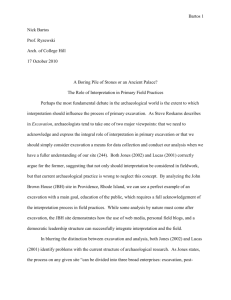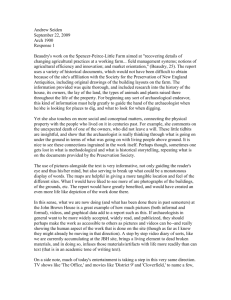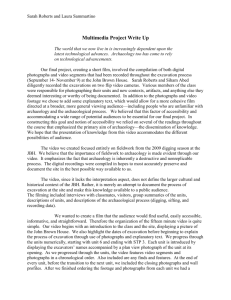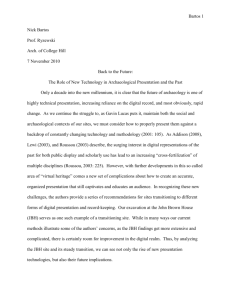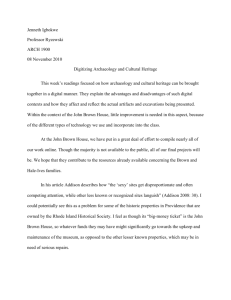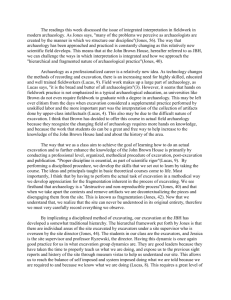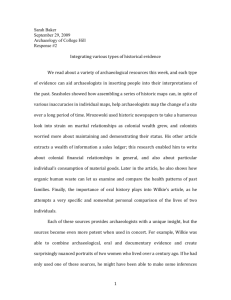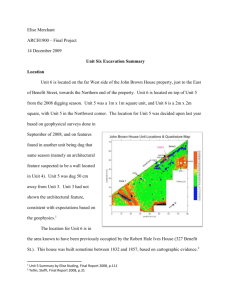Elise- Summary of Units 3 and 5
advertisement
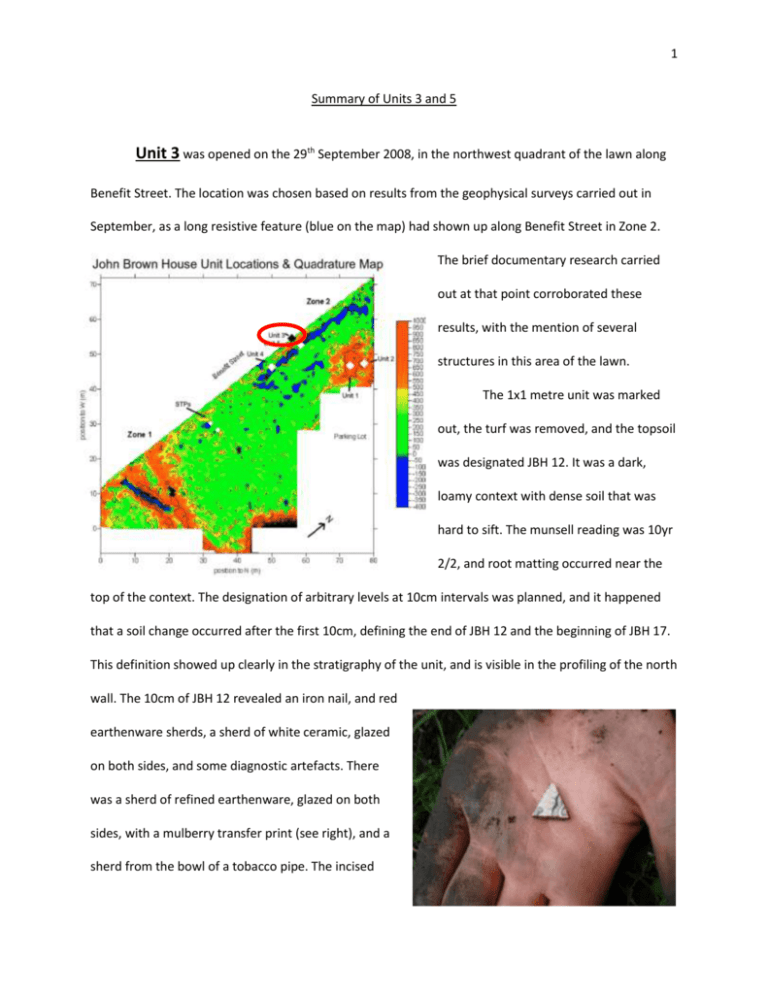
1 Summary of Units 3 and 5 Unit 3 was opened on the 29th September 2008, in the northwest quadrant of the lawn along Benefit Street. The location was chosen based on results from the geophysical surveys carried out in September, as a long resistive feature (blue on the map) had shown up along Benefit Street in Zone 2. The brief documentary research carried out at that point corroborated these results, with the mention of several structures in this area of the lawn. The 1x1 metre unit was marked out, the turf was removed, and the topsoil was designated JBH 12. It was a dark, loamy context with dense soil that was hard to sift. The munsell reading was 10yr 2/2, and root matting occurred near the top of the context. The designation of arbitrary levels at 10cm intervals was planned, and it happened that a soil change occurred after the first 10cm, defining the end of JBH 12 and the beginning of JBH 17. This definition showed up clearly in the stratigraphy of the unit, and is visible in the profiling of the north wall. The 10cm of JBH 12 revealed an iron nail, and red earthenware sherds, a sherd of white ceramic, glazed on both sides, and some diagnostic artefacts. There was a sherd of refined earthenware, glazed on both sides, with a mulberry transfer print (see right), and a sherd from the bowl of a tobacco pipe. The incised 2 design is irregular, suggesting that it was hand-made rather than machine formed. JBH 17 was the context below JBH 12, and had a distinctly different soil composition of a “mottled yellow/brown clay-ish soil”1 (shown left, the photo board was incorrectly marked). The planned 10cm was not accurately followed, resulting in JBH 17 extending down for 13cm to 3cm below the datum point (bd) in the NE corner. The artefacts found were 2 iron nails (one 10cm long),small brick shavings, a glass shard, small fragments of coal, and ceramic sherds. Two are diagnostic, a sherd of pearlware with a change of angle, and one with blue transfer print and a maker’s mark in the shape of a flower/clover leaf on the reverse. An arbitrary context, JBH 23 was assigned to the soil below JBH 17, as no soil change had been perceived. This lack of soil change between JBH 17 and JBH 23 is reflected in the stratigraphy of the north wall, however during excavation the soil change that occurred during JBH 23 was not allotted a separate context. The soil change does, however, seem to have been noticed, as the context sheet records observing “pockets of mortar” showing through towards the end of the 10cm, but it was not recognised as a separate context. There is a dichotomy between the total depths of the contexts excavated and the depths on the profile drawing of the north wall, but this aside, it is clear that there were natural strata on the north wall that were not identified during excavation. JBH 23 seems to span three strata on the profile of the north wall, starting at the end of the second, and finishing in places at 1 Elise’s field blog, Week Four 29/9/08, http://proteus.brown.edu/archaeologyofcollegehill/6387 3 the top of the fourth. JBH 23 was 10cm in depth, and was a loose brown soil, fairly uniform but slightly pebbly, with a munsell reading of 7.5yr 3,3, and pockets of mortar near the end of the context. The artefacts recovered are of similar composition to the previous two contexts, but in greater volume. Nails (whole and fragmented), coal, and glass were frequent finds, with two pieces of thick dark glass found that were unlike the thin translucent glass found previously. The diagnostic finds were 9 pieces of whitewear decorated with a pink sponge print that dates at the earliest to 1830, found in the north west quadrant of the unit (see right), and a sherd of thick redware with a green glaze. The date range of production for glazed redware is 1700-17702, which is an earlier date range than the range for sponge printed whitewear. Redware vessels were utilitarian, which is corroborated by the sherd’s thickness of 9mm as it was intended to be durable under frequent use. Its utilitarian nature also means that it would have been kept for use beyond the dates of manufacture, explaining how it can be in the same deposit as the whitewear dating from after 1830. A modern pull tab for a drinks can was also retrieved, and patent for this design was first obtained in 1963.3 Therefore, the earliest this stratigraphic layer could have been deposited is 1963. Consequently, the layers above JBH 23 must also have been deposited after this date. The glass, brick and nails that consistently appear in the contexts from Unit 3 are usually associated with architectural remains. When excavating JBH 17, the excavators had addressed the theory that they “may find traces of the structure that showed up on the geophysics in an earlier 2 Florida Museum of Natural History, ‘Mean Ceramic Manufacturing Dates’. This date range is for dark brown/black glazes. The green glaze dates to an earlier period. For more information see the object biography on this artifact, by Elise Nuding. 3 For more information, see the objects biography on this object by Elise Nuding 4 context, or it may be that JBH 17 was part of a construction trench for the structure”4. However, no evidence of architectural features appeared in Unit 3 which can be explained by the fact that Unit 3 was deliberately placed out of line with the resistive feature that had appeared in the geophysical results. The uniformity of the soil, and the range of dates for the artefact content suggests that the contexts of Unit 3 are fill. One possibility is that this fill was deposited in a construction trench related to the potential architectural structures that appear on the geophysical survey and that was uncovered in Unit 4 during week five. The TPQ established by the pull tab, however, suggests that although the contexts may be fill, they may not be associated with the structure on the geophysics results. JBH 28 was the next arbitrary context assigned, starting at 33cm and going until 43cm below the datum point in the north east corner. In examining the stratigraphy in the profile of the north wall, JBH 28 seems to begin near the top of the fourth strata, and extends down to the fifth. The soil was fairly uniform brown, quite moist, and it became pebblier as excavation continued. Fragments of coal and brick, as well as nails appeared in this context, in a continuation of artefact composition from the previous contexts. The number of ceramic sherds was significantly less than JBH 23, although significant diagnostic finds were the two sherds of Imari porcelain with gold leaf from the south west corner (see left), with a date range of 1700-17805. Like JBH 23, JBH 28 contained a modern 4 5 Elise’s field blog, Week Five 6/10/08, http://proteus.brown.edu/archaeologyofcollegehill/6387 FLMNH, http://www.flmnh.ufl.edu/histarch/gallery_types 5 artefact, the blade of a key (seen in the artefact photo below). It lends weight to the interpretation that the contexts in Unit 3 were fill, and also means that the TPQ is within the second half of the twentieth century, and that the deposit dates of the contexts above (JBH 12, 17, and 23) are determined by the TPQ of JBH 28. At 43cm below datum a new arbitrary context was assigned, JBH 34. The consistency was a loose medium brown soil, similar to the contexts above with a munsell value of 10YR 4/6. This context was only 2cm deep, as at approximately 45cm below the datum point a new natural layer appeared. This reddish, clay-y soil was assigned the context number JBH 40 (see right for end of JBH 34/top of JBH 40). On the profiling of the north wall, the start of the fifth stratigraphic layer seems to reflect the change observed during excavation. This is not consistent along the north wall, and JBH 28 breaches the fourth and fifth strata on the west side of the unit, with parts of JBH 28, 34 and 40 in the fifth stratigraphic layer. JBH 40 revealed artefacts consistent with previous contexts, coal and brick fragments, some nails, and a few ceramic sherds, although again the amount was lessening, suggesting that the excavators were reaching the end of the fill deposit. Significantly two larger pieces of brick were found in the southwest corner , one of size 45x45x20mm. This was the largest artefact recovered from Unit 3, and their discovery coincided with the beginning of a soil change. According to the excavators, “damp, white, loose and powdery”6 soil with a munsell reading of 7.5YR 4/4 began to show through, and it may be mortar associated with the bricks uncovered. Due to time 6 Moira’s field blog, 11.10.08, http://proteus.brown.edu/archaeologyofcollegehill/6385 6 constraints, this context was not able to be assigned a number, or excavated, and Unit 3 stopped excavation at 47cm below datum. Unit 5 was opened on 25th October, Community Archaeology Day during Brown University’s Family Weekend. A feature, possibly part of an architectural foundation, had been uncovered in Unit 4 but Unit 3 was not looking likely to reveal any architectural remains as indicated on the geophysics. This was not entirely surprising as the “placement of Unit 3 didn't exactly correspond to the area on the geophysics map that indicated a potential wall feature”7 It was decided to open up another unit, Unit 5, which was located 50cm to the east of Unit 3, in line with Unit 4 and in line with the resistive feature on the geophysics. The topsoil, JBH 27, had a munsell reading of 7.5YR-2.5-1. It was sandy silty soil of loose compaction, with moderately frequent small stones and humic deposits, and extended across the whole 1x1 metre of the unit. The finds from the unit consisted of some red brick fragments, four glass shards (3 clear and one coloured pink), a nail, and a portion of a brick with a maker’s mark. The soil composition is significantly different from the uniform brown soils in Unit 3, despite the mere 50cm in between, but is similar to the contexts excavated in Unit 4 above the feature. This suggested that the placement of Unit 5 coincided more with the geophysical survey. 7 Unit & Excavation Summaries, ‘Community Archaeology Day & Week 7’, http://proteus.brown.edu/archaeologyofcollegehill/6346 7 A change in context was visible between 8-10cm bd, and a new context was assigned. There was a clear division of contexts running approximately N-S on the east side, and this east context was labelled JBH 30. As excavation progressed, it became clear that the “western side was also similar. The two portions of the context were combined to be the same”8 The centre strip running N-S was labelled JBH 32. It was hypothesised on site that the disturbance might have been due to tree and root action, but this looked less likely as more of the contexts were excavated. JBH 30 was a dark greyish brown context with a munsell reading of 7.5YR-3-1. The soil was silty gravel, and of loose compaction. The context was later found to continue beneath the central context, but at this level the artefacts found were found to be continuous in composition from JBH 27, although they were greater in number. Mortar lumps, a 6x4cm shard of thick black glass, a lump of asphalt and lots of nails were removed. One diagnostic find was an object marked with ’30 amp’, and so thought to be part of some electrical feature. Some artefacts that might have been in situ features appeared in JBH 30. Two sizeable pieces of iron (see left), a piece of slate roofing, bricks, and a large stone. The plan drawing from the excavation sheet is shown juxtaposed with the site photograph (see below), to illustrate the layout of the contexts JBH 30 and JBH 32, and the placement of the larger artefacts within them as they were uncovered during excavation. The artefacts are clearly architectural debris that were probably disturbed by demolition and then deposited as some sort of fill. 8 Excavation form for JBH 30 8 JBH 32, running N-S in the centre of Unit 5, was distinguished from JBH 30 by sandy yellow patches of soil. The composition however was very similar- silty and gravelly. Architectural artefacts were also found in this context, most notable 2 partial bricks, one with a maker’s mark. It is the same maker’s mark seen on a brick recovered from Unit 2, and what can be read from the JBH 32 brick is “Fisher Co./ILLE NJ” (see below). The whole mark would have read “Sayre & Fisher Co./ Sayreville NJ”, and the town where the company was based did not change its name to Sayreville until 1870.9 This is the only diagnostic artefact from the context, and working from this the most accurate TPQ date that can be established for the deposit is 1870. More architectural debris in the form of nails and a section of a ceramic drainpipe, lined with a lead glaze, a large cobblestone with asphalt attached, and some larger asphalt lumps were removed. The asphalt turned out to be diagnostic, dating from after 1871, also allowing the cobblestone to be dated. The other set of diagnostic artefacts recovered from JBH 32 were as yet unidentified objects that were similar to the one recovered from JBH 30 (see below). Finding these objects in different contexts could mean 9 For a more detailed history of the bricks, see the object biography of the brick from Unit 2 by Megan Algeo 9 that JBH 32 and 30 were deposited at the same time, or that part of JBH 30 was removed and redeposited with JBH 32. A ceramic sherd of whitewear with a pink sponge print was found in JBH 32 that matched the sherds found in JBH 23 in Unit 3. This find has important implications for the relationship between Units 3 and 5 that is addressed later. JBH 32 disappeared from the centre as excavation progressed, revealing a triangular shaped context protruding southward from the north wall. This was labelled JBH 35. With JBH 32 removed, JBH 30 was seen to continue around JBH 35 below JBH 32. It continued as a dark greyish context, with extremely heavy gravel content. It was estimated that 60% of the context was gravel sized 1-5cm. It had relatively few artefacts, but continued to reveal some architectural debris of brick fragments and mortar lumps. Whilst removing JBH 30 in the very north east corner, a darker patch of soil had been identified, and was now seen to continue deeper, and so it was assigned a new context number, JBH 36. The plan view drawn on site indicates the layout of these contexts (see right). JBH 35 began at a depth of 21cm bd in the southwest corner. It was a darker yellow than the context above (JBH 32), and had a munsell reading of 10YR 5/3. It was described as sandy, loose soil, and had a high content of medium sized stones. Low artefact content, but a 25cm piece of iron bent at approximately a 10 100 degree angle was uncovered in the context. As more of the context was removed, it seemed to angle downwards towards the north wall. The context was not more than a few centimetres deep at the southern point of the triangle, but reached a depth of 20cm at some points, as seen on the profiling of the stratigraphy of the north wall (left). The deepening of the context suggests that a cut was made into the context of JBH 30 to deposit the context JBH 35, meaning JBH 30 predates JBH 35. Since JBH 30 was identified at approximately the same level as JBH 32, but continued deeper, JBH 32 also seems to have cut into JBH 30 when deposited. As JBH 30 did not extend as far as the north wall on the west side and centre of the unit, it is difficult to draw any conclusions about deposition sequence from the profile drawing, however it is clear that JBH 32 was deposited after JBH 35. JBH 36 was a very dark brown soil, with a munsell reading of 10YR 2/2, starting at approximately 20cm bd. The stratigraphy of the north wall does not reflect this record made during excavation, as JBH 30 is not visible between JBH 27 and JBH 36 (see above). The stratigraphy shows continuity between the topsoil and JBH 36 without showing a more gravelly section of JBH 30 in between. It may be that JBH 30 did not quite extend to the north wall, ending just before the end of unit perimeter, and creating a continuity of strata. If this is so, it may be that the excavators misidentified a continuation of JBH 27 as JBH 36. 11 The soil designated JBH 36 was semi-compact, being much clearer of gravel that the contexts surrounding it, and was interpreted to be a more natural soil that had been cut into when the fill contexts were deposited. If JBH 30 predates JBH 35, as is believed, then it would have been JBH 30 that cut into JBH 36 when deposited. The soil cannot have been entirely natural, however, as copper wires were discovered in JBH 36, protruding out of the eastern wall of the unit. At 25-32cm bd a lot of moderately sized rocks were showing through the gravelly context, and after clearing away the loose soil it was decided to assign a new context number, JBH 41. The rocks in the centre of the unit surrounded a hole that was less than 10cm deep, and there was another air pocket in the south east corner. The composition of the soil around the rocks was similar to that of JBH 30 above, although there were several large pockets of mortar showing through the gravelly gray soil. A plan of the unit was drawn to show the location of the rocks, (see above), with the air holes located at (55, 85) and (65, 70). Excavating more of the gravelly soil around the rocks, and removing the ones that were loose revealed a large rock that protruded out from the north wall of the unit (see right) , and that was clearly related to the rocks already removed, and 12 the ones still in place. These rocks were assigned feature number 7, but excavation was unable to progress any further due to time constraints. Feature 7 would seem to be an architectural foundation of the same type as found in Unit 4 several weeks earlier, and corroborates the geophysical survey that indicated the resistive feature running N-S in this location. Numerous lumps of mortar were removed from JBH 41, with several of them having a flat surface with imprints from the brick or stone they joined together. Five pieces of iron, ranging from approximately 4cm to 22cm in length were also removed (see right). One with a clearly defined ridge was related to one of the rocks that has rust marks on it, but it is not clear if this relation was from being juxtaposed after demolition, or from before. Excavation in Unit 5 was concluded between 49 and 58cm bd with Feature 7 exposed in JBH 41. The historical documentation available for this part of the site informs us that the Robert Hale Ives homestead was built between 1832 and 1857. This property, with the address of 327 Benefit Street existed on the site until the 1920s when Marsden Perry bought the house in 1923. By 1926 the structure was no longer standing. 10 It is likely that Feature 7 is related to the structure that was demolished in 1925-6, and that the 10 For a more detailed history of the Robert Hale Ives homestead and how it relates to our entire site, see Stephanie Yellin’s work on 327 Benefit Street. 13 architectural debris found consistently in Unit 5 is related to this demolition, even if it was removed and re-deposited at some point in the twentieth century. Research on the Robert Hale Ives homestead also revealed a 1908 Providence Platbook Map that shows a sewer line “running in a half circle between the house and the outhouse” (see above, sewer pipe circled in blue).11 The map is drawn to a scale that makes it hard to overlay the exact position of Unit 5, however the sewer line is roughly in the region of Unit 5, and could provide an explanation for the section of lead lined ceramic pipe found in JBH 32. The relationship between Units 3 and 5 is important to understanding the site. The contrast in soil composition between the units, despite their closeness has been noted. As excavation of Unit 5 progressed, comparing the west wall of Unit 5 with the east wall of Unit 3 revealed that the relationship is closer than would appear from analysing the soil (strata change highlighted with a red line in Unit 5 (above) and Unit 3 (below)). The rubble line from the top contexts in Unit 5 appeared on the 11 Ibid. 14 stratigtraphy of Unit 3’s east wall, suggesting that the soil near the top of Unit 3 might have been more similar to the soil at the top of Unit 5 than was realised during excavation. During excavation it was hypothesised that the “lighter, yellowish soil of JBH 30 may represent the division between [the feature in Unit 5] and the natural stratigraphy beyond it”, and a comparison with Unit 4 also suggests this. After uncovering the architectural feature, Unit 4 was excavated in two halves. The western half of the unit contained a “mottled orange-brown and dark brown, fine textured soil”12 that contained smaller artefacts, such as ceramics and glass, without any architectural debris. The eastern half of the unit was significantly different with contexts of rubbley and rocky soil that contained “architectural finds of large bricks, nails, and mortar”.13 The soil in the western half is very similar in composition to the contexts of Unit 3, and the eastern half of the unit is strikingly similar to what was uncovered in Unit 5. The conclusions drawn about Unit 4 are that the two halves of the unit represent the interior and the exterior of a structure, and with relation to Units 3 and 5, this interpretation holds weight. The change in soil was not as clear cut in Unit 5, but the feature was by no means fully excavated, and it was not established where the boundary of the feature was. The excavation of Unit 5 revealed architectural debris that is likely related to the demolition of the Hale Ives Homestead in the 1920s, although the material was probably disturbed and deposited in several fills. Unit 3 also contains fill, but of a very different nature. The date of deposit for the first few strata has been identified as after 1963, and since there is a relationship between the first strata of the corresponding walls of the units, it seems that the top strata of Unit 5 were also deposited after 1963. The presence of modern artefacts in Unit 3 means we cannot we cannot associate all the fill deposits with the Hale Ives structure, however it is possible that they were removed and re-deposited. This means that the interpretation of Unit 3 as originally being a construction trench, or in some way related to the architectural evidence of Unit 5, is still a valid one. 12 13 Unit & Excavation Summaries, Week 6, http://proteus.brown.edu/archaeologyofcollegehill/6346 Ibid., Community Archaeology Day & Week 7

